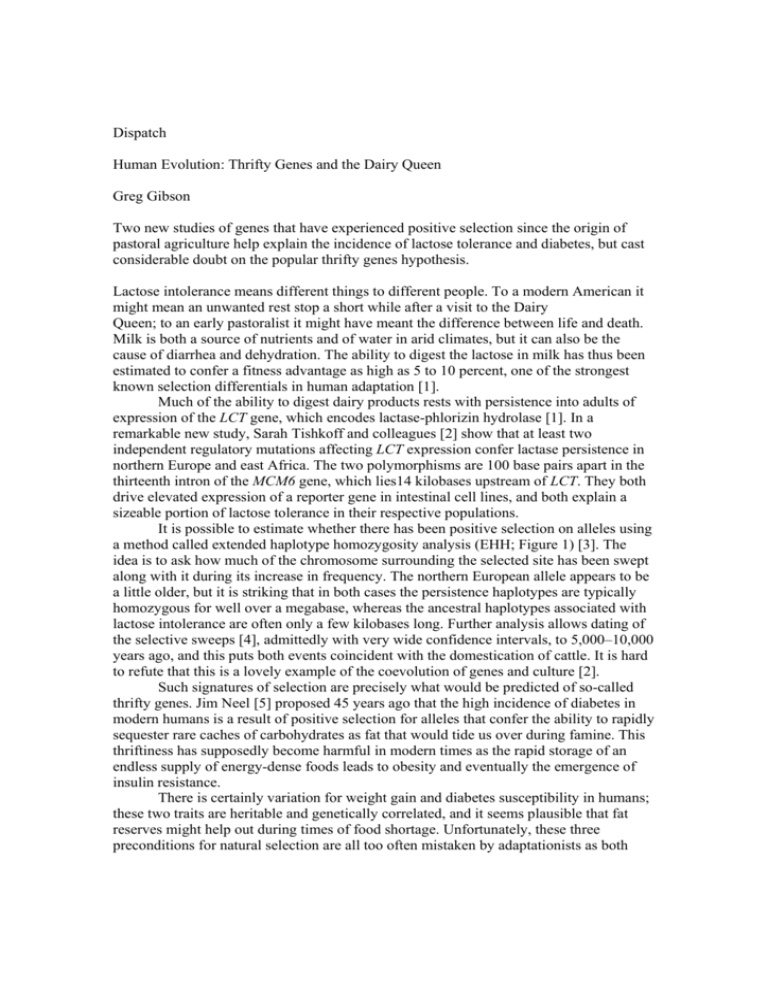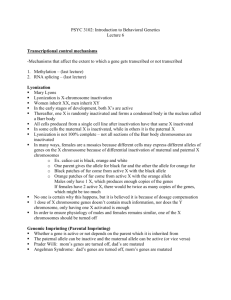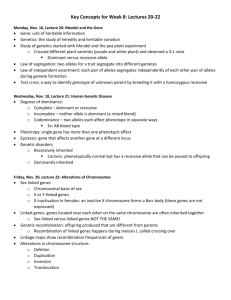Dispatch Human Evolution: Thrifty Genes and the Dairy Queen Greg
advertisement

Dispatch Human Evolution: Thrifty Genes and the Dairy Queen Greg Gibson Two new studies of genes that have experienced positive selection since the origin of pastoral agriculture help explain the incidence of lactose tolerance and diabetes, but cast considerable doubt on the popular thrifty genes hypothesis. Lactose intolerance means different things to different people. To a modern American it might mean an unwanted rest stop a short while after a visit to the Dairy Queen; to an early pastoralist it might have meant the difference between life and death. Milk is both a source of nutrients and of water in arid climates, but it can also be the cause of diarrhea and dehydration. The ability to digest the lactose in milk has thus been estimated to confer a fitness advantage as high as 5 to 10 percent, one of the strongest known selection differentials in human adaptation [1]. Much of the ability to digest dairy products rests with persistence into adults of expression of the LCT gene, which encodes lactase-phlorizin hydrolase [1]. In a remarkable new study, Sarah Tishkoff and colleagues [2] show that at least two independent regulatory mutations affecting LCT expression confer lactase persistence in northern Europe and east Africa. The two polymorphisms are 100 base pairs apart in the thirteenth intron of the MCM6 gene, which lies14 kilobases upstream of LCT. They both drive elevated expression of a reporter gene in intestinal cell lines, and both explain a sizeable portion of lactose tolerance in their respective populations. It is possible to estimate whether there has been positive selection on alleles using a method called extended haplotype homozygosity analysis (EHH; Figure 1) [3]. The idea is to ask how much of the chromosome surrounding the selected site has been swept along with it during its increase in frequency. The northern European allele appears to be a little older, but it is striking that in both cases the persistence haplotypes are typically homozygous for well over a megabase, whereas the ancestral haplotypes associated with lactose intolerance are often only a few kilobases long. Further analysis allows dating of the selective sweeps [4], admittedly with very wide confidence intervals, to 5,000–10,000 years ago, and this puts both events coincident with the domestication of cattle. It is hard to refute that this is a lovely example of the coevolution of genes and culture [2]. Such signatures of selection are precisely what would be predicted of so-called thrifty genes. Jim Neel [5] proposed 45 years ago that the high incidence of diabetes in modern humans is a result of positive selection for alleles that confer the ability to rapidly sequester rare caches of carbohydrates as fat that would tide us over during famine. This thriftiness has supposedly become harmful in modern times as the rapid storage of an endless supply of energy-dense foods leads to obesity and eventually the emergence of insulin resistance. There is certainly variation for weight gain and diabetes susceptibility in humans; these two traits are heritable and genetically correlated, and it seems plausible that fat reserves might help out during times of food shortage. Unfortunately, these three preconditions for natural selection are all too often mistaken by adaptationists as both necessary and sufficient for evolution to occur. But we need to be more quantitative if sufficiency is to be proven. A strong and to my mind persuasive critic of the thrifty gene paradigm is John Speakman [6]. His basic argument is that famines strong enough to cause significant mortality only come along once every few generations, that in such times mortality only increases by a few percent, that it has more to do with infectious disease than body weight, and that it really only affects young children and the post-reproductive elderly. It is thus unlikely that selection differentials in favor of thrifty alleles would be anywhere near the few percent required to spread to common frequencies since the Neolithic. In fact, recent genetic dissection of both obesity and diabetes fails to support the hypothesis either. According to the Obesity Gene Map [7] at http://obesitygene.pbrc.edu, 127 genes have been associated with weight gain, 22 of which have been replicated in at least five studies. In few of these cases have strong signatures of selection like that observed in LCT been described. Actually, for two of the best-known diabetes susceptibility factors, CAPN10 and PPARG, it is the derived allele that is protective against diabetes [8]. The risk allele in both cases has either been retained by balancing selection since our divergence from the great apes, or is being displaced by selection for the protective allele. Yet another dagger to the heart of the thrifty genes theory has just been published [9] with the revelation that a haplotype of the transcription factor gene TCF7L2 explains as much as 20 percent of diabetes risk in Europeans and Africans, but the risk allele is actually associated with reduced body mass index in diabetics. EHH analysis shows that the protective allele has been strongly selected in Japan where it is now almost fixed, whereas it remains at frequencies in the range of 10 to 30 percent in the rest of the world. Though the authors argue for a very mild effect on body mass in men with weights in the normal range, possibly by regulation of the appetite modulating hormones leptin and ghrelin [10], the data on this point are unconvincing. If replicated, the effect would in any case be the opposite of that predicted of a thrifty gene. A more compelling case can be made that this is a cryptic genetic variant, one whose effect is really only evident in the disease state once normal glucose homeostasis has been lost. Contemporary humans are afflicted with multiple complex diseases that are almost epidemic in nature. Diabetes, stroke, asthma and depression, to name just four examples, all are broadly attributable to disequilibrium between our genetic legacy and the modern environment that our species has created for itself. Those inclined toward Darwinian medicine like to explain disease as the price we pay for the beneficial effects of alleles that have accompanied human adaptation. These cases of not-so-thrifty genes suggest though that we should not be so quick to jump on the bandwagon: the coevolution of genes and culture is tremendously more complex. References 1. Swallow, D.M. (2003). Genetics of lactase persistence and lactose intolerance. Annu. Rev. Genet. 37, 197-219. 2. Tishkoff, S.A., Reed, F.A., Ranciaro, A., Voight, B.F., Babbitt, C.C., Silverman, J.S., Powell, K., Mortensen, H.M., Hirbo, J.B., Osman, M., et al. (2007). Convergent adaptation of human lactase persistence in Africa and Europe. Nat. Genet. 39, 31-40. 3. Sabeti, P.C., Reich, D.E., Higgins, J.M., Levine, H.Z., Richter, D.J., Schaffner, S.F., Gabriel, S.B., Platko, J.V., Patterson, N.J., McDonald, G.J., et al. (2002). Detecting recent positive selection in the human genome from haplotype structure. Nature 419, 832837. 4. Voight, B.F., Kudaravalli, S., Wen, X., and Pritchard, J.K. (2006). A map of recent positive selection in the human genome. PLoS Biol. 4, e72. 5. Neel, J.V. (1962). Diabetes mellitus: a ‘thrifty’ genotype rendered detrimental by ‘progress’? Am J Hum Genet.14, 353-362. 6. Speakman, J.R. (2006). Thrifty genes for obesity and the metabolic syndrome time to call off the search? Diab. Vasc. Dis. Res. 3, 7-11. 7. Rankinen, T., Zuberi, A., Chagnon, Y., Weisnagel, S.J., Argyropoulos, G., Walts, B., Pérusse, L., and Bouchard, C. (2006) The Human Obesity Gene Map: The 2005 Update. Obesity 14, 529-644. 8. Vander Molen, J., Frisse, L.M., Fullerton, S.M., Qian, Y., Del Bosque-Plata, L., Hudson, R.R., and Di Rienzo, A. (2005). Population genetics of CAPN10 and GPR35: implications for the evolution of type 2 diabetes variant. Am. J. Hum. Genet. 76, 548560. 9. Helgason. A., Palsson, S., Thorleifsson, G., Grant, S.F., Emilsson, V., Gunnarsdottir, S., Adeyemo, A., Chen, Y., Chen, G., Reynisdottir, I., et al. (2007). Refining the impact of TCF7L2 gene variants on type 2 diabetes and adaptive evolution. Nat. Genet. 39, 218-225. 10. Murphy, K.G., and Bloom, S.R. (2006). Gut hormones and the regulation of energy homeostasis. Nature 444, 854-859. Department of Genetics, North Carolina State University, Raleigh, North Carolina 27695, USA. E-mail: ggibson@ncsu.edu Figure 1. Extended haplotype homozygosity analysis. In an ancestral population (center), chromosomes are a mosaic of haplotypes, implied by the short blocks of color, and homozygosity in any individual usually only extends for a few kilobases surrounding any site. When a new allele appears it is in complete linkage disequilibrium with all other sites on the chromosome (the red haplotype fifth from the top). As this allele spreads, possibly under positive selection, recombination breaks up the linkage disequilibrium. If selection is strong (left-hand side) then the allele may sweep to fixation, carrying with it a large haplotype block, and as a result homozygosity can extend for hundreds or even thousands of kilobases. If it is weaker, the allele may remain polymorphic and the haplotype blocks, still shown in red, will be shorter. By comparison with coalescent simulations that vary demographic parameters such as population size, time since divergence, and recombination rate, it is possible to infer selection and even place a confidence interval on the time of origin of the allele [3,4]. Strong selection Weak selection Current Biology







